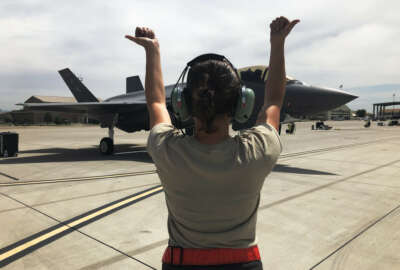

The Army and Marine Corps have sustained thousands of non-combat vehicle accidents. A review by the Government Accountability Office found the services don't always...
Best listening experience is on Chrome, Firefox or Safari. Subscribe to Federal Drive’s daily audio interviews on Apple Podcasts or PodcastOne.
Military training is supposed to train service members, not kill them. But the Army and Marine Corps have sustained thousands of non-combat vehicle accidents. In a 10-year period, 123 service members were killed. A review by the Government Accountability Office finds that the services don’t always employ their own preventive practices. GAO’s Director of Defense Capabilities and Management Issues, Cary Russell, had more details on Federal Drive with Tom Temin.
Interview transcript:
Tom Temin: Cary, good to have you back.
Cary Russell: Thanks for having me.
Tom Temin: And this issue of vehicles that overturn or crash, or otherwise end up in injury or death to service members, this has been a fairly persistent issue, hasn’t it?
Cary Russell: It has. We looked at 10 years worth of data and we found a number of accidents across that period. It varies, obviously, from year to year, but it’s a significant problem for sure.
Tom Temin: Because the photograph even going with the report summary shows, I guess that’s a, I don’t know what it is, a MRAP or something, a very, very heavy, large truck like thing completely on its lid. And that takes some doing the type of thing over like that.
Cary Russell: Yeah, it’s a significant concern. Obviously there are a lot of vehicles of that size that can and do rollover, and rollovers are particularly serious. As we looked at the 123 deaths that you talked about, almost two thirds of those actually come from rollover accidents. So they’re particularly serious.
Tom Temin: And what is the root cause of the persistence of these accidents?
Cary Russell: Well, as we looked into the data and looked at that 10 year period, we found that primarily human factors were the driver. And these are things like attentiveness of the driver, lapses in supervision, and overall lack of training, which are things that we get into and some of the findings and recommendations within the report.
Tom Temin: It sounds like the vehicle driving then almost might be considered wrongly, but nevertheless considered by the leaders there to be ancillary to the situation that they’re training the people in directly. That is to say, they need training in the operation of these vehicles, specifically, before they can be used for training for some situation.
Cary Russell: That’s right. I think as we looked at the training process, there’s licensing, which is really basic, it’s basic operations. But beyond that, for a driver to gain proficiency, it’s based on the experiences and the opportunities they have within those units to actually drive the vehicles in various conditions. And so, the amount of experience and the capabilities and the proficiency of those drivers is we found varied, considerably. And to give you an example of sort of what we’re talking about here, when you look at a Bradley fighting vehicle, for example, it has a large gun on it, it looks almost like a tank and then it carries infantry soldiers. There’s a gunner onboard that vehicle that has to have a very regimented training process to go through certifications and qualifications in order to be able to fire that weapon and establish essentially those those proficiencies. There’s no such training regimen in place for the driver of those vehicles. So there’s no performance based set of steps or procedures or different sets of experience that drivers are required to go through in order to attain proficiency. And so as a result, any given driver with any vehicle or even within units or within the services, their skill level can vary. And that creates a safety concern.
Tom Temin: And I imagine that the terrain in which they do operate, the training is by deliberation filled with ruts maybe and barriers to go over. And so it’s easier to tip over a thing or otherwise crash it, because you’re not driving on a smooth banked track.
Cary Russell: Oh, yeah, absolutely. The operations of these vehicles do go through very rough terrain, environmental conditions, weather conditions, at night is another concerns. So all these come to play. And so having that driver with those skill sets, and that level of proficiency in order to be able to operate at the level at which it’s needed to safely conduct those exercises is critical.
Tom Temin: And looking at the Army and the Marine Corps separately, is there a particular class or type of vehicle that is prevalent causing most of the accidents?
Cary Russell: No, I think we found that it’s pretty consistent across vehicles with the issues. And that kind of gets back to some of the findings that we have within the units. And particularly, one of the things we noticed was the safety practices that are put in place are really inconsistent. And a lot of that has to do with how those vehicle supervisors, those in line supervisors, or vehicle commanders apply safety standards. And it varies, again, across the set of vehicles and units. And what we found missing really was a good set of practices that would be in place that should be consistently followed, as well as a consistent level of roles, responsibilities and experience levels defined for those vehicle commanders. And so part of the recommendations that we’re making is that they do a better job establishing consistent safety practices and the right level of command emphasis in order to make sure that those safety practices are followed. Because some of the things that we’ve noticed as we’ve gone through the work was there’s a lot of mission pressures and time pressures on you to complete the mission to complete the training and all those can compete with safety. So it’s very important that there be a good, well defined role for those commanders, and that there be good procedures and practices put in place and followed in order to maintain the safety of the vehicles.
Tom Temin: We’re speaking with Cary Russell, director of defense capabilities and management issues at the Government Accountability Office. And yeah, let’s run through some of the other top line recommendations then.
Cary Russell: Sure, well, essentially as I mentioned before, so we have recommendations at at trying to improve the safety practices at the unit level by better defining the roles and responsibilities of those vehicle commanders. We also have recommendations in place to improve the training program for drivers so that there’s a more performance based program with steps to achieve those proficiencies at the driver level. And then we also have some recommendations aimed at the ranges themselves in terms of how the ranges identify and communicate hazards, for example, to the units and the drivers that are operating on those ranges, as well as a recommendation to create a forum for sharing lessons learned in best practices among ranges, which currently doesn’t exist. There’s several ranges out there that have a number of good practices in place, but they vary. And sharing that information and for one range, one base to learn from the experience of another is critical to improve the overall safety of training.
Tom Temin: And did the recommendations pretty much get a welcoming ear? Because I imagine the services can’t be happy about the number of soldiers and Marines they’re losing in this ongoing effort.
Cary Russell: Right. Absolutely. It’s a concern to the services as well. And they did receive good reception. We got concurrences on all the recommendations, and both the Army and Marine Corps agreed to take steps to implement them. So, we’re hopeful that some real change will be underway.
Tom Temin: Because for prosaic purposes of logistics and just keeping things operating, the military services also operate semi trucks with trailers and that kind of thing, just regular transport trucks. And it sounds like they probably spend more time training people to operate those trucks for prosaic purposes than maybe they spend training people to use combat vehicles in combat situations.
Cary Russell: I think you’re right. Absolutely. The motor transport drivers, which are the drivers specifically designed for trucks and transportation, they have a little bit more training within their school house and within their their career, whereas drivers of combat vehicles, such as the Bradley fighting vehicle, are infantry soldiers that are also cross trained on how to drive the vehicle. So there’s a little less training going on there for sure.
Tom Temin: Cary Russell is director of defense capabilities and management issues at the GAO. Thanks so much.
Cary Russell: Thank you, appreciate it.
Copyright © 2025 Federal News Network. All rights reserved. This website is not intended for users located within the European Economic Area.
Tom Temin is host of the Federal Drive and has been providing insight on federal technology and management issues for more than 30 years.
Follow @tteminWFED


